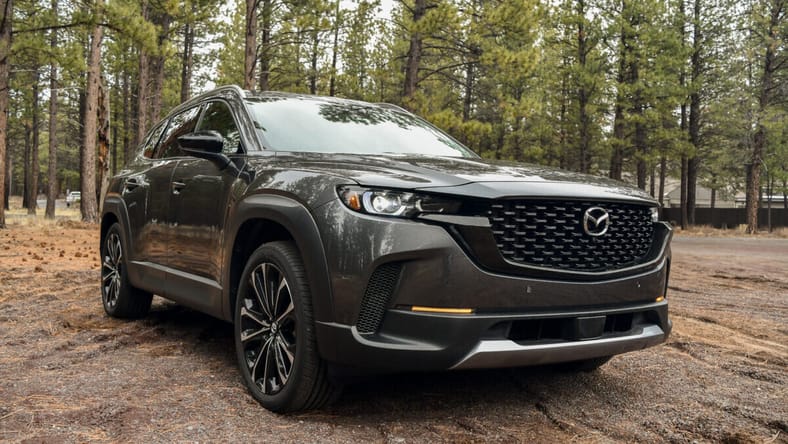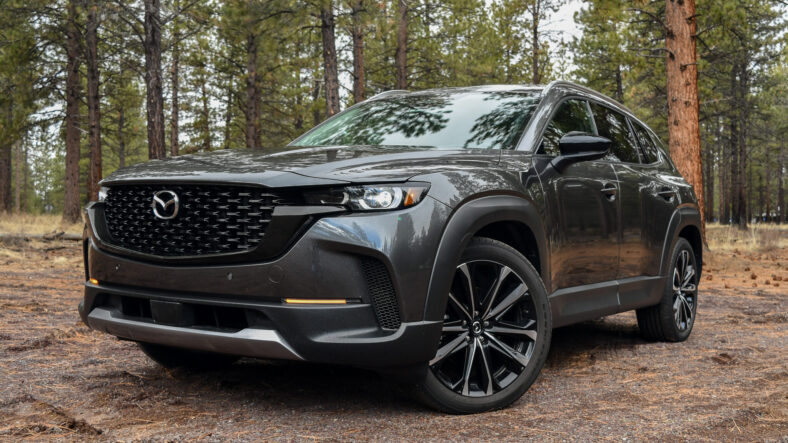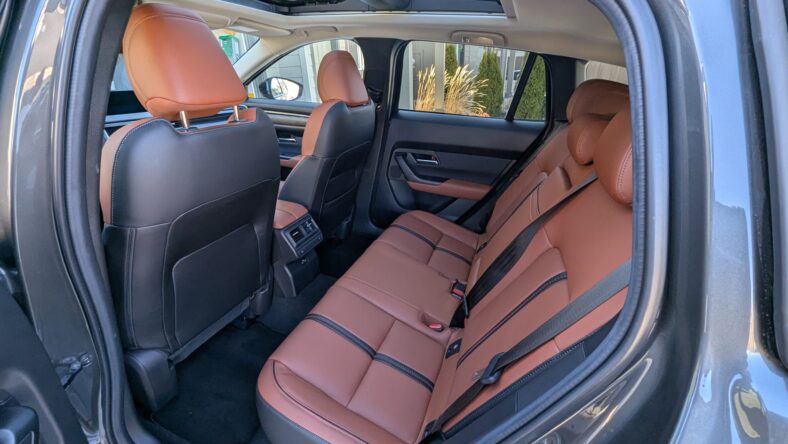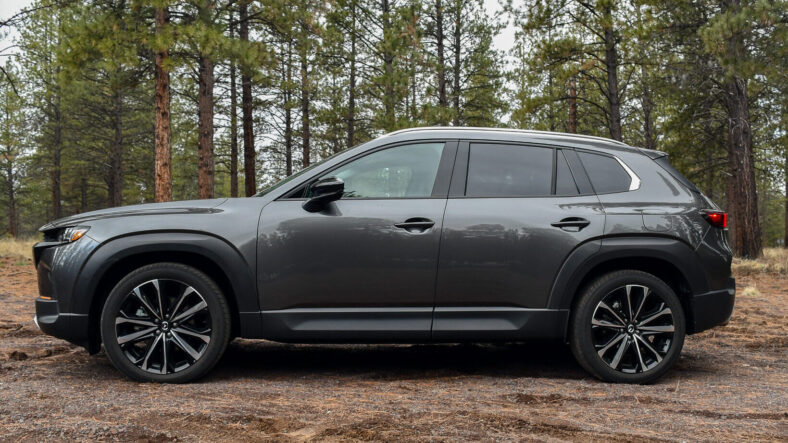The 2025 Mazda CX-50 Goes Premium—But Can it Outclass the Competition?
The Mazda CX-50 2.5 Turbo Premium Plus is class with a little bit of sass and plenty of power. But how does it measure up to others in the segment?

Mazda has always been known for making reliable vehicles that are fun to drive and sell at a very competitive price. They weren’t know for being luxurious, like a Mercedes-Benz, and most Mazda didn’t have very impressive interiors. However, people loyal to the brand knew they were getting a lot for their dollar, especially with the sporty Miata, the Mazda 6 sedan and the diminutive minivan-like Mazda 5.
But Mazda wanted more. They wanted to go premium, while maintaining what made Mazda, Mazda. Over the years we’ve seen the Miata get more sophisticated and upscale models like the full-sized, family-oriented CX-70 and CX-90 added to the lineup. The CX-50 was added to the family in the fall of 2021 boasting rugged but classy style, enough room for the family, capable all-wheel drive, and an optional punchy turbocharged engine.
The prices for 2025 range from $30,300 to $43,300 for the gas-powered model, $35,840 to $41,920 for the hybrid (which features the same setup as the RAV4 hybrid, by the way), proving that an efficient car didn’t have to break the bank. The CX-50 is now one of the brand’s best sellers.
However, with competition from the likes of the Honda CR-V, Toyota RAV4, Subaru Forester, Hyundai Tucson, and Kia Sportage, there has to be something special to make it stand out. After testing the 2.5 Turbo Premium Plus model for a week, let’s dig into how it fares against the AWD SUV segment’s top contenders.
This story is 100% human-researched and written based on actual first-person knowledge, extensive experience, and expertise on the subject of cars and trucks.
There’s One Thing That Stands Out: A Boostable Turbocharger

From the outside, most wouldn’t assume that the Mazda CX-50 2.5 Turbo Premium Plus had been spending some time in the gym. A turbocharger from the factory boosts the horsepower from a modest 187 horsepower to 227 horsepower. Which, for a small SUV, is more than enough power to put a smile on your face when you put the pedal to the metal.
But here’s something you might want to put in your back pocket—the CX-50 Turbo Premium Plus is engineered to produce a maximum of 256 horsepower with the addition of premium-grade fuel. So, the Mazda CX-50 can become a thoroughbred with a simple (and slightly more expensive) trip to the gas station.
Here’s why that’s important: only one competitor, the Honda CR-V EX-L AWD, has a turbocharger. However, as far as horsepower is concerned, the Mazda still comes out on top. The Toyota RAV4 comes close with 203 horsepower from its turbo-less 2.5-liter four-cylinder, but every other competitor ranges from 180 to 190 horsepower.
So, if you want a car that has pep in its step with regular grade fuel but can dance with some premium, I can hear the Mazda CX-50 Turbo Premium Plus calling you.
However, The Mazda CX-50’s Power Comes at a Notable Cost

When comparing it to its competition, the Mazda is the most expensive option. The Turbo Premium Plus starts at $43,300. Which may not seem like a lot compared to other turbocharged SUVs available today, and it’s not—but pricing is where the competition can seem a lot more appealing.
The Hyundai Tucson Limited AWD starts at $40,145, the Toyota RAV4 Limited AWD’s MSRP is $38,995, then the Subaru Forester Touring comes in at $38,490, the Kia Sportage SX-Prestige with AWD starts at $36,790, and then the Honda CR-V EX-L AWD—the only other one with a turbo—starts at $36,500.
If towing a [very] small camper is important to you, the added horsepower comes in handy here, as it gives the CX-50 a very modest towing capacity of 3,500 lbs. Every other SUV can tow between 1,500 to 2,500 lbs.
So, horsepower has to really matter to you to justify the difference in price to other AWD SUVs in the market.
Alright, What About Cargo Space?

The brown and black leather interior was gorgeous and very attractive for rear passengers, but a sporty and very low roofline made me feel a tad claustrophobic, though, of course, that’s subjective. My husband, who stands at 6’1″, didn’t mind the low roof. However, the overall cargo space was sacrificed in favor of styling.
Out of its competitors, the Mazda CX-50 has the least amount of cargo space, with 31.4 cubic feet of space behind the rear seats and 56.3 cubic feet with them folded. The Kia Sportage has the most space behind the rear seats with 39.6 cubic feet, and the Honda has the most with the rear seats folded with a figure of 76.5 cubic feet with the rear seats folded.
The Hyundai came in third, then it was the Toyota RAV4, and the Subaru Forester. In terms of cargo space, the Mazda came in dead last for overall capacity. It has more space behind the rear seats than the Subaru, but with a low roof line, there’s less vertical space for larger items, putting it in last place.
READ MORE: The Best Thing About the 2025 Mazda CX-50 Hybrid? It Uses the Toyota Hybrid System
The Antiquated Driver Dash Left Me Wanting More

I always appreciate it when daily functions are buttons and knobs instead of being setting buried in a touchscreen. I also love a tasteful-sized media touchscreen with Android Auto built in, since it makes navigation, phone calls, and using Google Assistant a breeze. I didn’t find that in the Mazda CX-50.
It has a screen, but it’s only a touch screen when you use Android Auto or Apple CarPlay. Otherwise, Mazda’s operating system—which hasn’t been updated since its debut in 2011—hasn’t been adapted for touchscreens. Therefore, if you have to use any controls in the original settings, you have to use a wheel and buttons. It’s great for people who are intimidated by technology, but if you’re not, I’d bet you’d find it frustrating not being able to touch and swipe through settings.
The media screen was also one of the smallest I’ve encountered, which isn’t a problem for those who are vehemently against big screens in their cars. But for me, the first thing I thought was, “This is the interior that comes in a $43,300 car?”
If you’re a fan of minimalist but functional interiors, the Mazda is for you. But the Hyundai, Subaru, and Honda had much classier interiors and a more modern and responsive operating system than the Mazda.
The Mazda CX-50 Fits Our Car Seats, But it’s Tight

One thing about the CX-50’s family-friendliness is this: the 2.5 Turbo Premium Plus was one of the easiest cars I’ve tested to get car seats into. My oldest is front-facing while my youngest is rear-facing, and my oldest’s car seat was a breeze. The top tether was behind the seat and easy to access through the trunk, and the lower anchors were behind an easy-to-interpret plastic cover. Just remove the cover, and the frame anchors were right there—click, tighten, and repeat.
Being front-facing, my oldest could easily kick the passenger’s seat (sorry, hubby), and she didn’t like how the low seating position paired with relatively small passenger windows. She did, however, adore the large sunroof. My youngest, though, couldn’t see out of her passenger window, the rear window, or the sunroof, so she was grumpy about the CX-50.
If you have older kids, though, the CX-50 would work—just keep in mind that the legroom is fairly limited for tall passengers. My husband noted that his knees were fairly high up, so long road trips would be uncomfortable for him. But he did appreciate the large sunroof opening up the rear for passengers.
Compared to the competition, Subaru, Hyundai, and Honda’s rear seat comfort, space, rear seat installation, and visibility were hard to beat.
READ MORE: Navigating the Great Outdoors in the 2024 Mazda CX-50
Combined Mileage Was Respectable for an AWD SUV

Even with a punchy turbocharged engine (and even punchier with premium octane), the CX-50 2.5 Turbo Premium Plus performed very similarly to its competitors in terms of mileage. In Bend, Oregon, with low speeds, frequent stops, and short-distance driving, I was averaging about 24 miles to the gallon.
Mazda’s website says the CX-50, even with AWD, averages 23 mpg in the city, 29 on the highway, and 25 combined. Which, for a full-time AWD SUV, is respectable. Every competitor listed averages one or two miles per gallon less or more, except for the Toyota RAV4. It came in first, even without the hybrid setup. It came out ahead with 25 mpg in the city, 33 on the highway, and 28 combined.
On paper, the Mazda CX-50 came second-to-last in this category behind the Kia. However, even with that, it’s still not bad.
I was very impressed with how well the six-speed automatic—not a CVT—adapted to both city and highway driving, and I loved its smooth and quiet ride. Except when you give the beans, then the Mazda CX-50 emits a very pleasant purr from its dual exhaust setup.
The CX-50 is About as Safe as They Come

While it might lack cargo space, miles per gallon, and screens, the Mazda CX-50 is certainly not lacking safety features or creature comforts. In Bend, where the cold is biting, I quickly grew fond of the heated steering wheel and heated driver’s seat. Rear seat heaters are standard, too, as well as a 12-speaker Bose sound system.
The Honda doesn’t come with an updated sound system as standard equipment; it has to be added on—and passengers aren’t treated to a large sunroof, heated seats in the rear, or ventilated front seats. The Toyota doesn’t have heated rear seats, either.
The Mazda comes with a 360-degree camera, parking sensors, a rear-facing camera, a surround camera to help with parking, automatic emergency braking, adaptive cruise control, rear cross-traffic alert systems, and blind spot monitoring. All features that its competition has, except for the Honda. The CR-V has a surround view camera, and only has parking sensors in the rear.
The Hyundai and Kia, though, have some form of highway driving assistance, while the Mazda (and every other competitor listed) doesn’t. So, if that’s important to you, that’s something to keep in mind.
READ MORE: Mazda CX-50 Hybrid Vs. Toyota RAV4 Hybrid: Same Engine, Same MPG. Which is Better?
Now, Let’s Talk About Off-Road Readiness

Now, “all-wheel drive” isn’t necessarily synonymous with “off-road ready.” But when it comes to the Mazda CX-50 2.5 Turbo Premium Plus, it’s very close. It’s hard to beat the Subaru Forester in this category, but the Mazda is nipping at its heels while the others are benched unless you opt for other off-road-ready trim levels. The Subaru has the highest ground clearance in the segment at 8.7 inches, but the CX-50’s ground clearance is 8.6 inches—a barely noticeable difference.
The other SUVs listed all start at 8.2 inches, with the Hyundai and Kia resting at 8.3. The all-wheel drive system is effective on the Mazda, though not as powerful as the Subaru’s. While the Subaru has the dual-function X-MODE with four terrain modes, the Mazda comes with “Off-Road Traction Assist” as part of the Intelligent Drive Select (Mi-Drive).
It adjusts the throttle response, tunes traction control, and the all-wheel drive’s power distribution to help on gravel, sand, mud, and snow, making it incredibly adept in multi-season climates. The Mazda CX-50 Turbo 2.5 Premium Plus is no Meridian trim level, but it’s incredibly close—the only things missing are all-terrain tires, but the Subaru Forester Touring doesn’t have them, either. Only in the Wilderness edition.
After Putting My Kids In It, Would I Say It’s Family Friendly?

Not necessarily, at least not for car seat-bound toddlers or infants. As I mentioned before, I could probably install car seats blindfolded because it was so easy. However, for long drives, neither of my toddlers was happy with the limited visibility. Now, if my girls were, say, 13 and 12, they’d be able to appreciate the climate controls, heated seats, USB charging ports, and sound system.
Plus, I wouldn’t need as much cargo space with them being older. Needing to carry a diaper bag for my youngest translated to less space in the trunk, so carrying luggage, groceries, or gear would be more difficult. However, adding cross bars and a roof basket or cargo box would help.
If you’re looking to buy a capable AWD SUV with a healthy dose of beauty and power to haul your growing family, the Mazda may feel cramped compared to the Hyundai Tucson Limited or the Toyota RAV4 Limited. The Subaru has the space and the comfort, but certainly doesn’t have the power, style, or tech like the Hyundai.
If your children aren’t in car seats, however, the Mazda’s driving style and design make it hard to beat, as it checks all other boxes.
READ MORE: 7 Secrets that Make Mazda SUVs and Sedans Fan Favorites — and 1 Common Complaint
So, Who Was Mazda Targeting with the CX-50 2.5 Turbo Premium Plus?

When you look at the webpage for the Mazda CX-50 2.5 Turbo Premium Plus, or the CX-50 in general, you see images of the SUV doing adventurous things. Going off-road, parking at a campsite, carrying gear like skis or kayaks, or driving through the snow. So, without a doubt, Mazda’s looking directly at Subaru’s buyers.
However, the addition of the powerful turbocharger, sporty styling, rugged looks, and leather interior means the CX-50 could also attract young professionals with older children who enjoy the great outdoors on the weekends in a car with plenty of pep to make the annual drive to the lake an exciting one.
The CX-50 is a blast to drive, very attractive, and fits right into the Central Oregon crowd. However, I found it almost dreadfully dull on the inside without modern tech and a dinky screen, and the pricing turned me off, as it seems a little expensive compared to what’s available for the driver.
Plus, the incredibly antiquated operating system and the screen only being a touch screen when Apple CarPlay or Android Auto (which required a hard connection to activate, so keep a USB cable handy) was active was baffling to me. Especially when each one of its competitors was more tech-forward at a lower price.
Overall, I enjoyed my time with the Mazda CX-50 2.5 Turbo Premium Plus. It’s an absolutely gorgeous car, and I adored the brown and black leather interior. If I didn’t have children to cart around, the Mazda would definitely be in my top 10 favorite cars I’ve reviewed from a driving feel standpoint.
More About:Car Reviews SUVs
